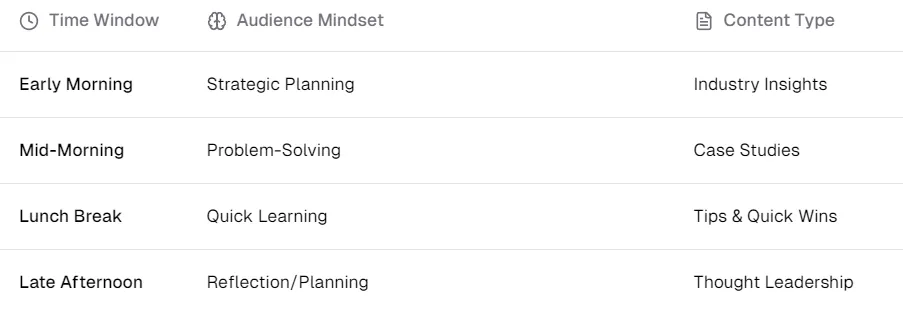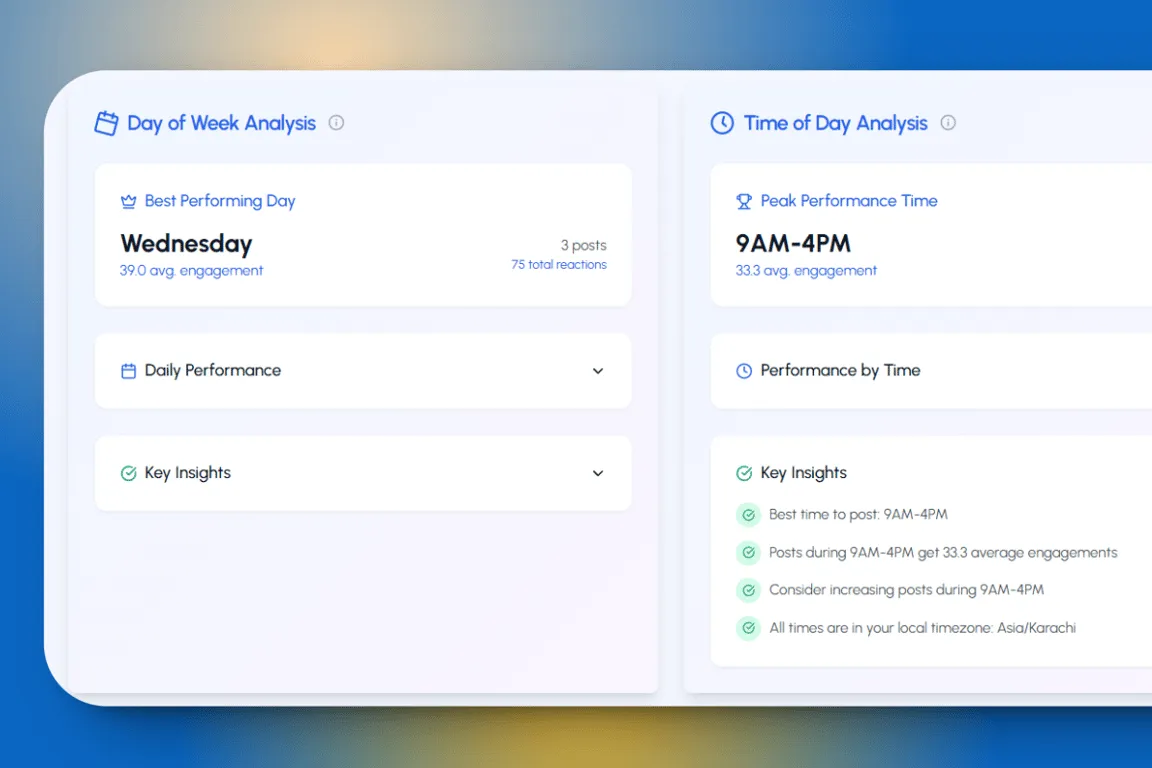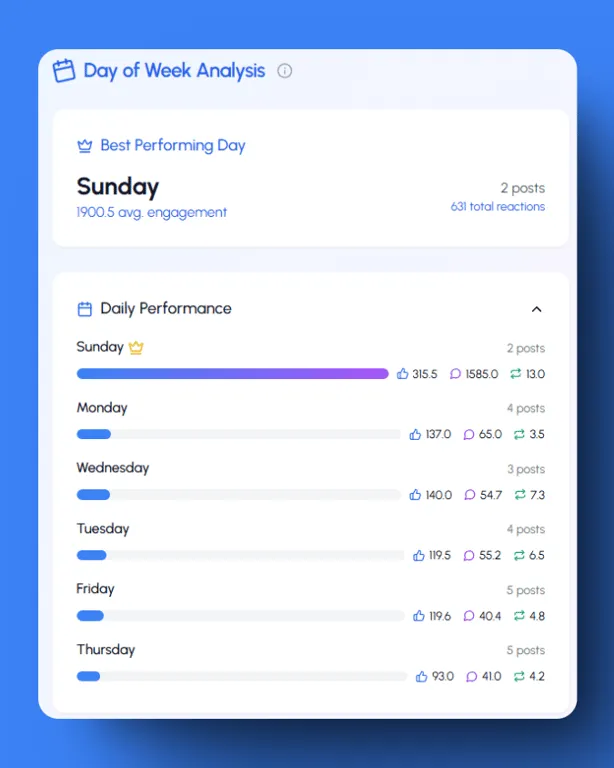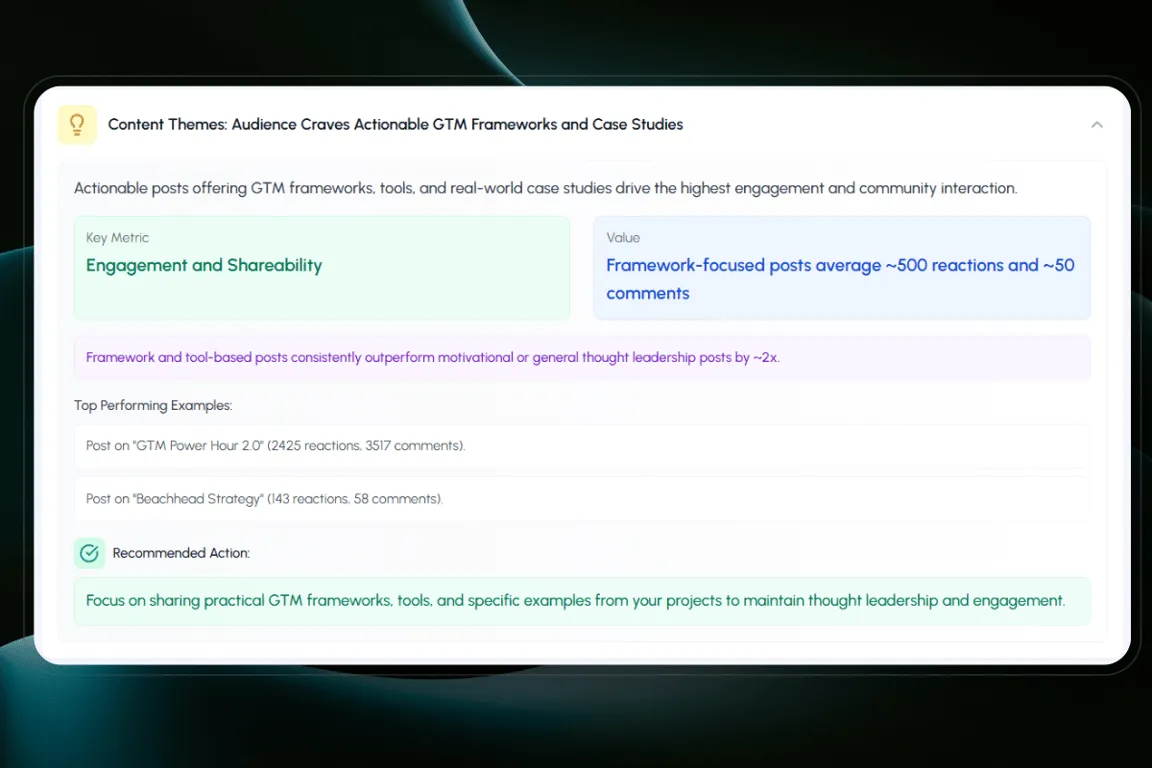Timing matters.
Each audience is different and has different engagement patterns. There's no one size fits all.
In this article, we'll discuss tips on how you can figure out the best time for your industry and how you can leverage that information to generate real revenue from LinkedIn.
Understanding Your Audience's Time Patterns
Ever noticed how your LinkedIn feed feels different at 9 AM versus 2 PM?
There's a reason for that. Your audience isn't just scrolling – they're working. Unlike Instagram or Twitter, LinkedIn engagement directly correlates with professional schedules.
Look at any professional's LinkedIn activity and you'll notice clear patterns in how they engage throughout the day:

See that difference? Each window attracts a different kind of engagement.
The Quality vs. Quantity Game
A post getting 200 reactions at noon might seem better than one getting 50 reactions at 8 AM. Until you look closer.
Those early morning posts? They often generate:
-
Longer, more thoughtful comments
-
Direct messages from decision-makers
-
Shares with internal teams
Why? Because your audience is in strategy mode, not scroll mode.
Making Data-Driven Timing Decisions
This is where most advice falls apart. They'll tell you "post at 9 AM on Tuesday!" and call it a day.
Reality is messier. And more interesting.
Start With Your Data
First step: Look at your own engagement patterns. Not just when you get the most likes – when you get the most valuable engagement.
Track your optimal posting times with LiGo Analytics.
Your Three-Window Strategy
Instead of chasing one "perfect" time, identify three key windows:
-
Prime Time (Your highest-quality engagement period)
-
Use for your most important content
-
Often early morning or late afternoon
-
When decision-makers are most active
-
-
Engagement Time (Highest overall engagement)
-
Perfect for brand-building content
-
Usually mid-day
-
When your broader audience is active
-
-
Testing Time (Your experimental window)
-
Try new content types
-
Test different angles
-
Learn what resonates when
-
A software agency I worked with discovered something counterintuitive: Their technical posts performed better at 4 PM than at 10 AM. Why? Because that's when their clients were actually implementing solutions and hitting roadblocks.
The Multi-Timezone Reality
For agencies working across borders, timing gets trickier. You're not just posting for New York – you might be targeting London, Singapore, and Sydney.
The solution? Don't try to hit every timezone. Focus on your primary market first:
-
Track when your target clients are most active
-
Identify their working patterns
-
Align your most valuable content with their peak problem-solving times
Use LiGo's AI Insights to analyze your audience's engagement patterns.
Timing is just one piece of the puzzle. A mediocre post at the perfect time still fails. An exceptional post at a decent time still wins.
The goal isn't to game the system – it's to meet your audience when they're ready to engage meaningfully with your content.
Industry-Specific Patterns
Different industries, different rhythms. Let's look at how various professional services engage on LinkedIn.
Software & Tech Agencies
The most valuable engagement for tech agencies rarely comes from peak traffic hours. It's about catching your audience in problem-solving mode.
Take this scenario from a dev agency in our network: Their highest engagement came during 11 AM-1 PM, but their most valuable interactions (actual client inquiries) happened at different times:
-
Early morning (7-9 AM): CTOs and tech leads mapping out their day
-
Late afternoon (3-5 PM): Project managers looking for solutions to that day's challenges
This makes perfect sense when you think about how tech leaders structure their day:
-
Strategy Mode (Early Morning)
-
Technical leaders reviewing priorities
-
Perfect for thought leadership content
-
Discussions about industry trends
-
-
Problem-Solving Mode (Mid-Day)
-
Teams hitting technical roadblocks
-
Case studies get more attention
-
Direct solution queries
-
-
Planning Mode (Late Afternoon)
-
Next-sprint planning sessions
-
Higher interest in methodologies
-
Budget discussions
-
[visual CTA: "Track your best-performing content times with LiGo Analytics"]
Management Consulting
For consultants, timing isn't just about the hour – it's about understanding the meeting culture.
The Meeting Gap Approach
Instead of targeting peak hours, look for the gaps between meetings:
-
Pre-meeting windows (typically 8-9 AM)
-
Lunch breaks (12-1 PM, varies by region)
-
End-of-day reflection (5-6 PM)
A fascinating insight: While your analytics might show higher general engagement during busy hours, the meaningful conversations often happen during these "gap" periods.
Content-Time Alignment
Match your content type to your audience's mental state:

Advanced Timing Strategies
Now this is where it gets interesting.
The Pre-Peak Advantage
Looking at your analytics, you might see clear peak engagement times. But posting slightly before these peaks can actually work better. Three reasons why:
-
Less competition in the feed
-
More focused attention from your audience
-
Higher chance of meaningful engagement
One tech consultancy shifted their posts to 30 minutes before their usual peak time. The result? Fewer overall reactions but twice the number of qualified leads. They caught their audience before the noise kicked in.
Cross-Border Timing
For agencies working internationally, timing becomes more nuanced. Rather than trying to hit every timezone, start with your primary market:
-
Which region generates most of your business?
-
When do these clients typically make decisions?
-
What's their typical workday pattern?

The Content-Time Matrix
Your posting time should align with your content's goal:
-
Thought leadership → Early morning or evening (reflection times)
-
Technical solutions → Mid-day (problem-solving hours)
-
Case studies → Late afternoon (planning for tomorrow)
-
Quick tips → Lunch breaks (quick-consumption content)
The point isn't to maximize views – it's about reaching the right people when they're most receptive to your message. Raw engagement numbers only tell part of the story.
Each time slot has its own personality. Your job isn't to find the "perfect" time – it's to match your content with moments when your audience is in the right mindset to engage with it.
Reading Your Analytics Right
Raw data tells a story - if you know how to read it.
Day-by-Day Performance
When you look at your LinkedIn analytics, you'll see a breakdown by day of the week. But don't just jump at the highest-performing day. Look deeper:
-
What type of content worked on each day?
-
Which days got more comments vs. just reactions?
-
Are certain topics performing better on specific days?

Get detailed day-by-day performance analysis with LiGo Analytics.
Time Blocks That Matter
LiGo's time-of-day analysis breaks down your 24 hours into strategic blocks. Let's decode what these patterns usually mean:

Pro tip: Look at the engagement-per-post metric for each time block. A time slot with fewer posts but higher average engagement often signals an underutilized opportunity. You can ask LiGo-chan to give you this metric.
Beyond Basic Metrics
Your analytics dashboard shows three key performance indicators:
-
Average engagement per post
-
Total posts per time block
-
Engagement trends over time
But the real gold lies in combining these metrics. For instance, if your 11AM-1PM block shows:
-
Highest total engagement
-
Lower engagement per post
-
Declining trend over time
This might indicate content saturation during peak hours - a signal to experiment with other time slots.
Making Analytics Actionable
Data without action is just numbers on a screen. Here's how to turn your timing insights into a practical strategy.
Pattern Recognition
LiGo's AI insights analyze your posting history to identify patterns like:
-
Which content types perform best at different hours
-
Engagement velocity during different time blocks
-
Comment quality variations throughout the day
Armed with these insights, you can:
-
Schedule your highest-value content during proven engagement windows
-
Test new time slots for different content types
-
Adjust your strategy based on real performance data
The Experimentation Framework
When your analytics suggest a new opportunity (like a high-performing time slot you haven't fully utilized), follow this testing approach:
-
Baseline Measurement
-
Track current performance metrics
-
Note engagement types (reactions vs. comments)
-
Monitor audience interaction quality
-
-
Controlled Testing
-
Post similar content types
-
Maintain consistent formatting
-
Only change the timing variable
-
-
Performance Analysis
-
Compare engagement metrics
-
Look at comment quality
-
Track direct inquiries or leads
-
Seasonal Adjustments
Your analytics will show performance variations across different time periods. Pay attention to:
-
Monthly trends
-
Quarterly patterns
-
Year-over-year changes
These longer-term views help you anticipate and adapt to changing engagement patterns.
Smart move: Use LiGo's AI chat feature to dig deeper into your data. Ask questions like:
-
"Which of my posts got the most meaningful comments?"
-
"What's the trend in engagement for my technical posts?"
-
"How has my best posting time changed over the last quarter?"
The goal isn't just collecting data - it's understanding the story behind it. When you see a spike in engagement at an unusual time, ask yourself: What was different about that post? That day? That audience interaction?
Chat with your LinkedIn data using LiGo's AI insights.
Common Timing Pitfalls
After working with hundreds of agencies and freelancers, certain timing mistakes keep popping up. Let's tackle them head-on.
Consistency vs. Optimization
Many professionals fall into one of two traps:
-
Posting at the same time every day without testing
-
Constantly changing times without gathering enough data
The solution? Smart experimentation. Your analytics dashboard shows engagement patterns over time - use this data to make informed decisions. When you spot a high-performing time slot, test it consistently for at least 2-3 weeks before drawing conclusions.
The "Peak Hours" Trap
Just because 11AM-1PM shows the highest overall engagement doesn't mean it's your best posting time. Look at your engagement-per-post metrics instead:
-
A crowded time slot might get more total engagement
-
But your content might stand out better in a less crowded window
-
Quality of engagement often trumps quantity

Set-and-Forget Scheduling
Your optimal posting times aren't static. They change with:
-
Seasonal business cycles
-
Industry trends
-
Audience behavior shifts
-
Platform algorithm updates
Smart tip: Review your timing analytics monthly. Look for emerging patterns and adjustment opportunities.
Future-Proofing Your Timing Strategy
The LinkedIn landscape keeps evolving. Here's how to stay ahead.
Adapting to Work Pattern Changes
Remote work has scattered traditional office hours. Your analytics might show:
-
Earlier morning engagement
-
Extended evening activity
-
More weekend interaction
Use your dashboard's time-of-day analysis to spot these shifts early and adjust accordingly.
AI-Powered Optimization
This is where things get exciting. Modern tools like LiGo don't just show you when to post - they help you understand why certain times work better:
-
AI analysis of engagement patterns
-
Content-timing correlations
-
Audience behavior insights
The Human Element
While data drives decisions, don't forget the human side:
-
Your audience's daily routines
-
Industry-specific schedules
-
Regional business cultures
Chat with your LinkedIn data through LiGo's AI feature to uncover these deeper patterns.
Your 30-Day Action Plan
Let's turn these insights into action.
Week 1: Baseline Assessment
-
Review your current posting times
-
Analyze engagement patterns
-
Identify top-performing slots
Week 2: Strategic Testing
-
Experiment with pre-peak posting
-
Track engagement quality
-
Monitor comment patterns
Week 3: Refinement
-
Adjust based on Week 2 data
-
Test content-time combinations
-
Document performance changes
Week 4: Optimization
-
Lock in best-performing times
-
Create a flexible posting schedule
-
Set up regular performance reviews
Final Thoughts
Timing on LinkedIn isn't about finding one perfect moment. It's about understanding your audience's rhythms and matching your content to their needs.
Great timing amplifies great content - but it can't fix poor content. Focus first on value, then use timing to ensure that value reaches the right people at the right moment.
Your next step? Log into your analytics dashboard. Look at your best-performing posts. When did they go live? What was different about those times? The answers might surprise you.
This article is part of our 30-day Linkedin Roadmap. If you are just getting started on Linkedin, then let's start from the beginning:
Linkedin Growth: The Complete Roadmap for 2025
Also featured in Week 1: Linkedin Content Creation: Your first week guide




